Email marketing software gives you the highest return on investment (ROI) among marketing channels – $38 for every $1 spent.
Plus, there are 1.5 billion active Gmail users – all of them could be potential customers.
How do you get started?
The best email marketing services, software, and platforms all have different price points and features.
Most of these tools are great – you just need to find the best match for you.
For example, if you’re sales-driven and want to care about email deliverability and marketing tools, Constant Contact is a great choice.
If you’re a blogger, a text-based welcome email series from ConvertKit would be a strong pick. Or if you’re selling products online, image-heavy, product-focused emails look great with Benchmark.
In this guide, I researched and ranked the best email marketing service providers to help you pick the best one for you, and save the most money.
Let’s get started.
What is the Best Email Marketing Software?
To choose from the best email marketing software, research price, reliability, technical support, template designs, ease of use, deliverability, automation, integrations, and any additional features you need.
The best email marketing software should allow you to design emails easily, segment your list, personalize your messaging, and view analytics reports. And they should most importantly hit users’ primary inboxes.
In the end, email marketing is about sending the right message to the right user at the right time.
1. Moosend.
Excellent All-In-One Email Marketing Automation Tool (Free – $8+/month based on list size)
Moosend is an email automation tool that helps you build your email list, personalize your messages, and automate tasks so you can focus on customer relationships.
They have intuitive drag-and-drop email templates in their campaign builder. This tool lets you add images, text blocks, social icons, and more to your emails. They have a large library of email templates with different layouts that are responsive and look great on desktop or mobile.
The area that Moosend stands out is the automation features. Using their “Recipes” (pre-built automation templates), you can automate messages via upsells, customer engagement, and customer loyalty. Every automation has three main components: the triggers, control steps, and actions. When you combine all three, you can filter email list segments and send sequences when your specified actions occur.
Some other key Moosend features include:
- Landing Page Builder Tools: Create custom webpages with email sign-up forms to increase conversions.
- Automation Workflows: These templates let you personalize your emails and nurture customer relationships with ease.
- Custom Opt-In Forms: You can design and create custom forms to let visitors subscribe to your email list.
- List Segmentation: Segment your list based on customer behavior like engagement metrics, abandoned cart emails, and more.
- Reporting Tools: Their analytics tools provide a bird’s eye view of all of your important email metrics.
- Customer Support: Each paid plan provides phone support. Custom enterprise plans all provide an account manager and support via email, phone, and live chat. They also have video tutorials and a huge knowledge base to answer your questions.
The pricing for Moosend is based on the number of subscribers in your email list. They provide a free plan for users with under 1,000 subscribers and includes sign-up forms, reporting, and the ability to send unlimited emails.
Moosend paid plans begin at $8 per month and scale up with the number of subscribers. Every paid plan comes with access to transactional emails, page builders, and SMTP servers. Their enterprise plans provide migration and onboarding support, and Security Assertion Markup Language (SAML).
If you’re looking for advanced email automation tools, give Moosend a try.
2. Constant Contact.
Best Email Marketing Service for Small Business ($16/month)
Constant Contact has been in the email marketing space since 1995, taking the name Constant Contact back in 2004. In 2015, they became a part of Endurance International Group, a powerhouse that other companies including Bluehost, HostGator, and Domain.com.
As stated on their website, the company’s ultimate goal is to help small businesses navigate the promise, power, and potential of the web.
They feature 100+ modern, mobile-optimized templates to engage and convert customers, real-time reporting and analytics, and bonus features like coupons, polls, and events.
One of their most unique features is event management and the ability to manage invitations, registrations, and tickets:
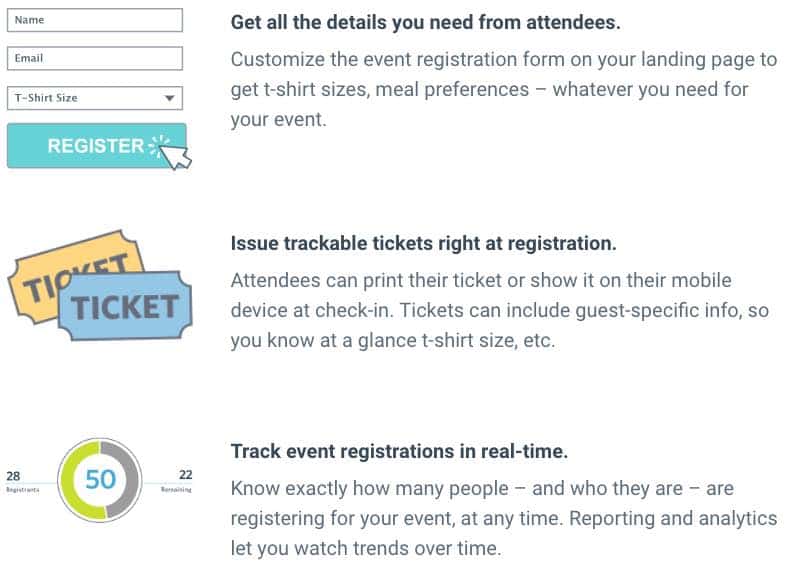
Email deliverability is above average and one of the highest among email service providers at over 90%.
Constant Contact pricing is tiered based on the number of email contacts in your list. Their paid plans start at $18/month for up to 500 contacts.
Their drip campaigns are easy to use and intuitive. You can create simple sequences, but can’t combine conditions or use advanced filtering.
Ultimately, if you’re looking for niche features like event management and also want top-notch email deliverability, Constant Contact is the choice for you. They are my #2 choice for email service providers this year.
You can get started today and take 10% off your first 12 months with my link below.
3. Sendinblue.
Best Email Marketing Service with Automation on a Budget ($20/month)
Sendinblue is an easy to use email marketing service with a free plan that allows unlimited contacts, and 300 email newsletter sends per day. If you’re serious about growing your list, you can use their Lite plan which starts at $20/month and allows up to 40,000 sends per month and no daily sending limit.
Their free platform is all built on ease of use. Its simplicity allows you to easily create clean-looking templates, automated welcome emails, and website opt-in forms. They also offer live chat and CRM in their free plan, which includes one automation workflow for up to 2,000 contacts.
Sendinblue also uses machine learning and AI to send emails at the best time of the day to maximize engagement.
You can also view real-time statistics with necessary reports that provide metrics like open rates, click-through rates, deliverability, and heat maps.
One of their best features is their email automation workflows. These allow you to set triggers and put your subscribers through custom workflows based on actions they take on your website and in the funnel:
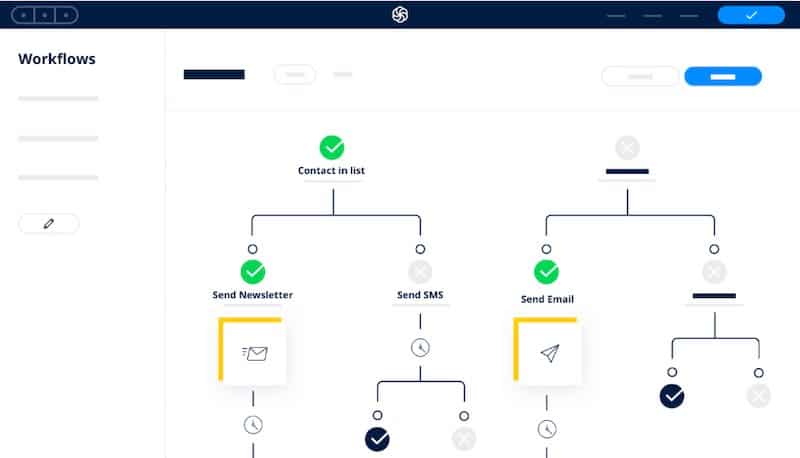
These automated triggers create actions like sending emails and SMS messages, segmenting your contacts into separate lists, and updating their information in your database.
If you want advanced email marketing automation software on a budget, you can get started with their Lite Plan for $20/month and save 10% on annual plans.
4. HubSpot.
Best Email Marketing Software for Marketers (Free – $50/month)
HubSpot is the most integrated marketing package on the market. Using their email marketing software is one of the easiest ways to design, optimize, and send fantastic looking emails. They provide a ton of custom features and you can pick and plan and upgrade whether you’re a small business or large enterprise.
When creating an email, you either use one of their pre-made email templates or start from scratch. These templates allow you to add text, images, buttons, dividers, and all different kinds of assets and layouts.
I found their email editor the easiest to use on the market. It’s much faster and more user-friendly than other tools on this list:
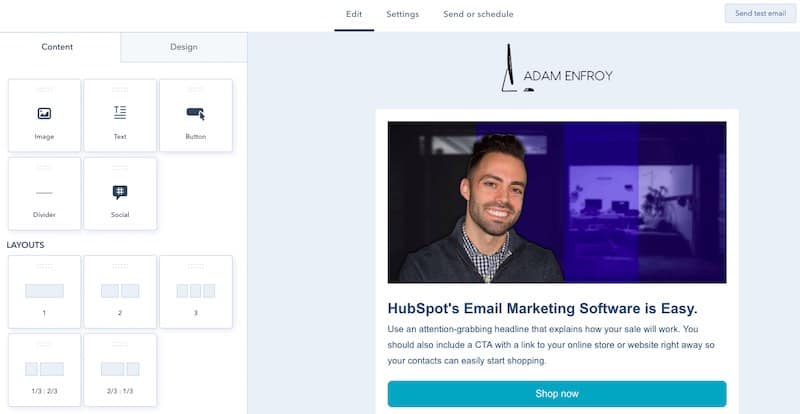
Once you’re happy with your email design, preview it based on different recipients, devices, or email clients like Gmail, Apple Mail, and Office 365.
This tool is super useful. Email subject lines, preview text, and the content itself can look very different based on the end user’s email client. These previews ensure your emails look great in any inbox.
Personalization is another strength with HubSpot. Like standard tools, you personalize content based on common merge tags like the recipient’s first name. HubSpot takes it a step further.
You can also personalize content based on a user’s device, list segment, and geographic location. Plus, you can A/B test your subject lines and content to make sure you maximize your email open rates and click rates.
Next, when you’re ready to hit send and publish your email, you can use their Smart Send functionality. This feature allows you to adjust your send time to maximize engagement.
After sending your email, it’s time to view your metrics. The HubSpot analytics dashboard gives you data on your opens and clicks, plus unique information on the amount of time spend viewing your email.
Viewing whether subscribers Read, Skimmed, or Glanced at your email is one of the best reporting tools to observe how engaging your email content is:
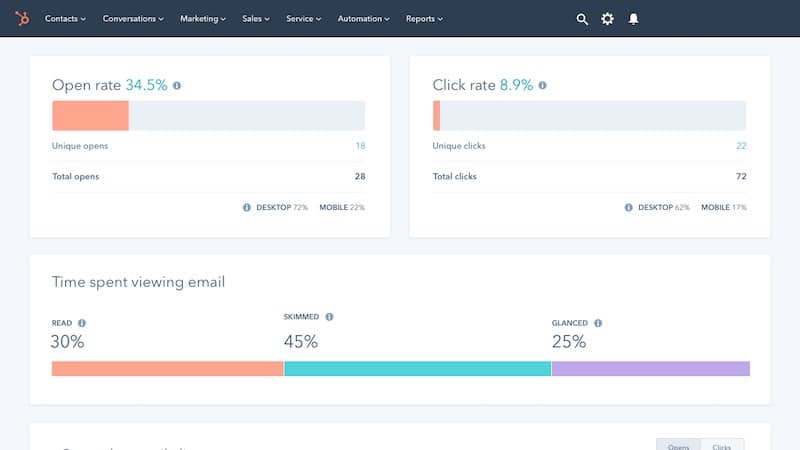
For example, you may see that subscribers are only glancing at your emails for a short time. This data helps you know which types of email content need to be improved.
Consistently hitting users’ inboxes is another benefit with HubSpot. They have a healthy 99% email deliverability rate. These substantial numbers are due to proper domain validation settings with DKIM and SPF records, plus the ability to thoroughly preview and test emails.
The main reason that HubSpot is #1 on my list is that their email marketing platform is just one aspect of their product. The real benefits come with their Marketing Hub Starter Package.
This full marketing platform includes email marketing and everything else to align your marketing and sales efforts:
- Full-featured CRM
- Automated sequences
- Mobile optimization
- Personal calendar to schedule appointments
- Gmail extensions to track email sends and automate outreach
- Form builders
- Inbound lead, email, and ad analytics
- Phone and email support
HubSpot is my #3 pick for the best email marketing software for one simple reason: It perfectly aligns your inbound and outbound marketing in the most efficient way possible.
I recommend you get started for free, then upgrade to their Marketing Hub Starter Package for $50/month.
5. Mailerlite.
Best Ease of Use and 24/7 Support (Free – $10/month)
Over 600,000 customers around the world use Mailerlite. They have flexible tiered plans based on the size of your contact list.
They are best known for their easy user interface, responsive email designs, and excellent 24/7 phone support and email support. You can start with their forever free plan if you have less than 1,000 email subscribers.
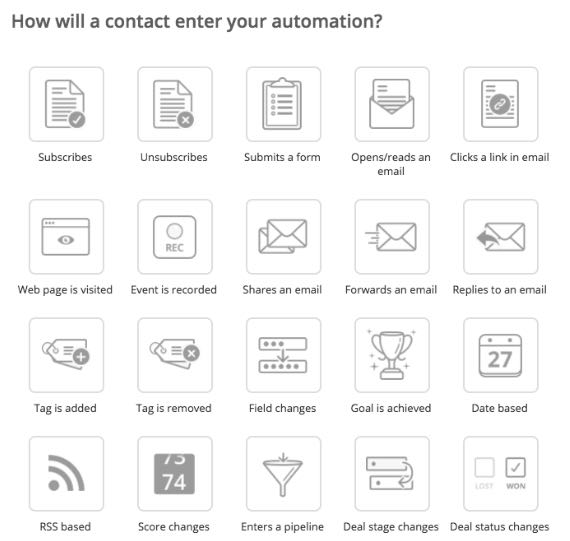
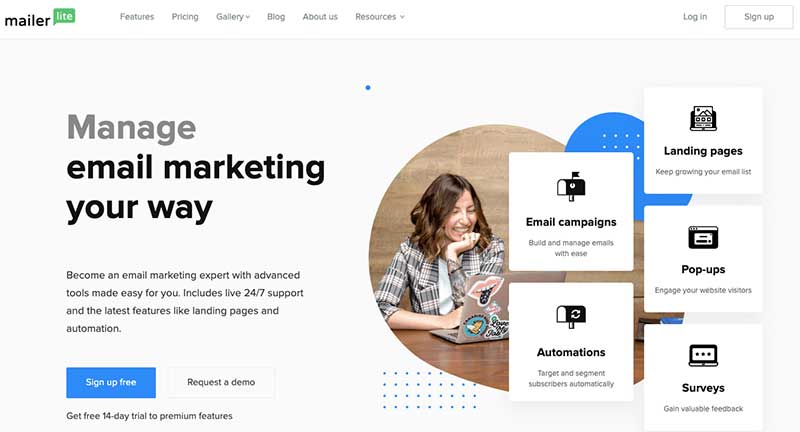
This free plan has limited features and allows you to send up to 12,000 emails per month.
Upgrading to their $10/month plan gives you access to all features that help your marketing strategy, including a landing page builder, embedded forms, and pop-ups.
With Mailerlite, you can track your email marketing results with a click map and opens by location reports.
They also provide some other great features, including:
- Live 24/7 customer support via chat and email
- A powerful and easy to use landing page builder
- Ecommerce integrations with the top platforms
- Email surveys
- Template Gallery
- Amazing email deliverability
Overall, if you’re looking for flexible pricing, want excellent deliverability, and don’t have a large list yet, give Mailerlite a try.
6. GetResponse.
Best Automated Sales Funnels and Landing Page Features ($15/month)
GetResponse is an all-in-one online marketing platform to grow your business. They offer email marketing campaigns, high-converting landing pages, and webinar software to help your marketing efforts.
The real standout here is Autofunnel – a tool with 30+ ready-made landing pages, email templates, and sequences to generate sales. And you can choose your end goals.
Whether you want to drive lead generation, product sales, or webinar registrations, Autofunnel is the answer. They’re optimized to nurture your email list and maximize your funnel’s conversion rates:
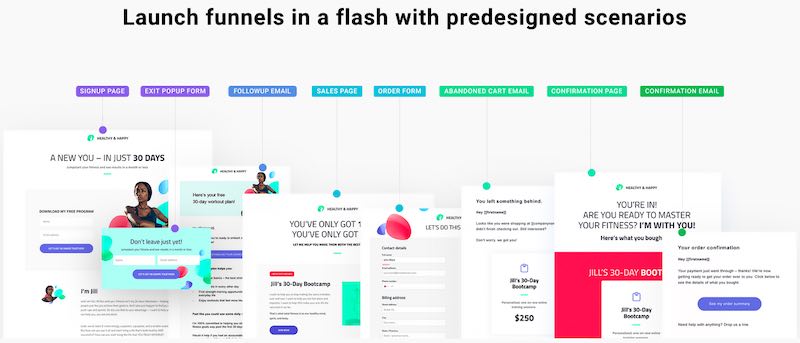
On the downside, some of their 500 templates look a bit outdated, and they have middle-of-the-pack deliverability compared to others on this list.
However, one of GetResponse’s biggest strengths is its smart automation tools. Using these features, you create multiple advanced conditions to segment your lists automatically. Their drag-and-drop builder is also very intuitive and makes designing high-quality emails a breeze.
Overall, GetResponse is one of the best email marketing tools to create automated sales funnels and landing pages.
You can get started with a 30-day free trial and upgrade to their $15/month Basic Plan. You also save between 18 and 30% with annual plans.
7. Pabbly Email Marketing.
Excellent Inbox Delivery and Independent SMTP Service ($29/month)
Pabbly is an online platform, which offers a full-service suite of marketing tools for online form building, email marketing, subscription billing, and email list cleaning. Also, it provides a complete business management bundle of all these tools at a low cost named Pabbly Plus.
Pabbly’s email marketing service doesn’t restrict you on features like marketing automation, list management, autoresponder emails, segmentation of subscribers, etc. whether it’s a paid or free plan. You can effortlessly integrate in-built or 50+ external SMTPs and send emails without any additional charges.
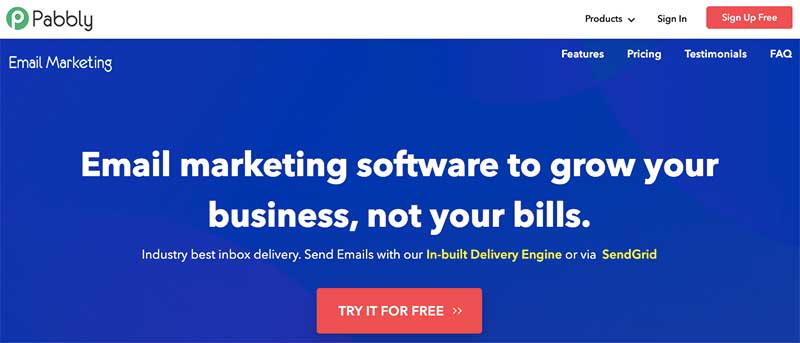
With Pabbly Email Marketing, you can boost your email marketing performance by running campaigns and send bulk emails to all your prospective users in just one click. Also, it handles bounce and spam complaints about all popular SMTP services such as Amazon SES, MailGun, Mandrill, SendGrid, etc.
The pricing for Pabbly Email Marketing is based on your number of subscribers. Here’s a comparison of annual savings vs. other popular options on this list:
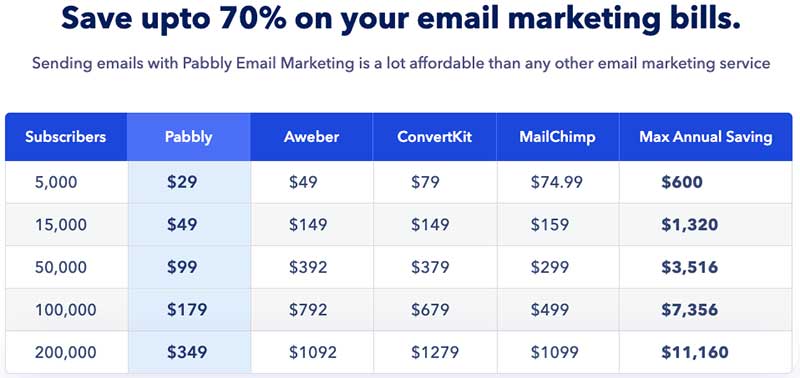
Some other important features include:
- Some highlight features of Pabbly Email Marketing include:
- A user-friendly drag-and-drop email editor
- 500+ Email templates that accept all types of customizations
- Collect leads & business-related information via its subscription forms
- Connect multiple SMTPs to route emails through multiple vendors
- Improve open rates by removing the invalid emails from your list with MX cleaner
- Send automatic follow-up emails to non-opens
- Use autoresponders and interact with the users without any manual efforts
- Automatically send emails on pre-set schedules for engaging the subscribers
Its email platform has a 99% delivery rate and they’re a great option if you’re looking for a service to regularly clean your list and keep your database up to date.
Get started with Pabbly Email Marketing.
8. ConvertKit.
Best Email Marketing for Bloggers ($29/month)
ConvertKit is built by creators, for creators. They understand their client’s needs and know what it takes to grow an online following.
They boast attractive forms, increase conversion rates with automated emails, and organize your subscribers to maximize engagement.
For bloggers looking to send personalized, text-based emails, their designs look like they’re coming right from Gmail.
Additionally, they offer pretty advanced email sequences based on both site actions and actions within emails. Their advanced triggers make for some excellent list segmentation options:
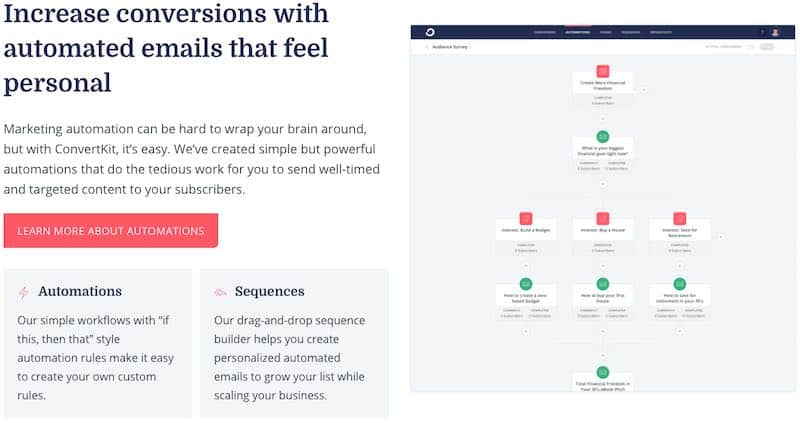
ConvertKit is also a strong pick for a few main reasons:
- You can use advanced segmentation based on different actions to personalize your email funnels.
- Your text emails look professional and don’t have annoying email branding.
- The best emails for your blog will be strictly text. Don’t worry about fancy design features, adding your logo, or a bunch of imagery.
Ultimately, it’s an excellent platform for lead funnels.
For example, if a sales professional were trying to close a big deal, they would close it with either a phone call or a simple text-based email. They wouldn’t use an image-heavy marketing email full of company branding.
Although they don’t have a free plan, with pricing starts at $29/month and a 14-day free trial, it’s a great choice for bloggers focused on building high converting sales funnels.
Get started with ConvertKit – my top choice for bloggers.
What is Email Marketing?
A simple email marketing definition is the use of email to promote products or services. Even better, email marketing is a way to use email to nurture and develop relationships with your email subscribers to complete an end goal like a sale.
Email marketing is just one form of digital marketing, which also includes things like search engine marketing, social media, SEO, blogging, etc.
Before email, direct mail was a way to reach consumers in their mailbox. Email marketing takes this strategy online by sending messages to users electronically to their email inbox. Unlike direct mail, email requires a user to opt-in to your email list to receive your messages.
How Does Email Marketing Software Work?
Email marketing software (or e-mail marketing) is using online platforms to send out bulk marketing email messages to your list of subscribers. This tactic allows you to acquire new customers better, enhance relationships, and encourage customer loyalty.
With email marketing campaigns, you can quickly and easily reach your audience exactly where they are without having to pay for expensive advertising space on Google or Facebook.
The best email marketing software works by leveraging some of these essential features:
1. Automation.
The ability to send email sequences when a user joins your mailing list or performs an action on your website. These could include making a purchase or abandoning their shopping cart.
2. Custom email templates.
Drag-and-drop email campaigns take the coding requirements out of email marketing so you can focus on adding content and images to your emails.
3. Dynamic content.
You can use merge tags in your emails to customize them for each member of your email list, by dynamically changing.
4. List segmentation.
The longer you engage with your email list, the more data you collect, including open rates, interests, purchase history, and more.
5. Analytics dashboard.
E, including open rates, click-through rates, purchases, and more.
6. Advanced features.
Look out for other cool features to add to your campaigns like polls, contests, coupons, and events.
What Are the Benefits of Email Marketing Platforms?
Email marketing is crucial because it is one of the best ways to build a loyal following, generate revenue, and find users where they hang out – their inbox.
When a user opts-in to your email list, they have shown interest in your business and are ready to receive your messages. Since 74% of buyers identify word of mouth influencing their purchasing decisions, email is a natural extension of that ability to collect and share information that’s important to them.
Additionally, if you’re in sales, email is the third most influential source of information for B2B audiences behind only personal workplace connections and recommendations from industry thought leaders.
By choosing the best email service, you cost-effectively send messages at scale, speak to warm leads without cold email outreach, and don’t pay a fee outside of your monthly subscription.
Here are more benefits of using email marketing services:
- Email marketing is cost-effective and has a proven ROI (every dollar spent can create a $44 return on investment)
- Ease of use and pre-designed email designers make creating stunning and mobile-friendly emails a breeze
- Email is one form of multi-channel marketing that builds customer loyalty and brand awareness
- You reach your customers exactly where they are – their inbox
- Email allows marketers to reach their audience with relevant, personalized, dynamic messages – 74% of marketers say personalization increases customer engagement.
- Automated emails like abandoned cart emails, welcome emails, and post-purchase emails allow you to generate incremental revenue with little work or time required
- Email marketing options are endless and you can find easy-to-use tools whether you’re a small business or large enterprise.
What Are Some Email Marketing Best Practices?
Email marketing isn’t as simple as writing a message and sending it to a list of contacts. There are a lot of email marketing best practices to follow and email marketing industry benchmarks to hit.
Here are some of the top email marketing best practices to be successful this year:
1. Do Not Use Purchased Email Lists.
Email marketing is so effective because people want to engage with your business and receive your message. Buying email lists takes away this trust by spamming their inbox with something they don’t want.
And the penalties for not following these rules are severe. According to Keap (formerly Infusionsoft), you can be fined up to $16,000 per incorrect email under the CAN-SPAM Act.
The health of your email campaigns depends on a healthy open rate. If you are interacting with a purchased list, you’re bound to have super-low open rates, spam complaints, and can even be blacklisted.
With the recent General Data Protection Guarantee (GDPR) rollout, it bears repeating – never purchase email lists. You should also clean your email list regularly to ensure your contacts are up to date.
2. Personalize Content with Merge Tags.
An email titled, “Dear {first name}” is much more personal than “Dear Member.” Any piece of data that you collect from your email subscribers should be used to personalize the content they receive.
If the item fits in a column within a CSV file next to their email address, a merge tag can fire. A merge tag is a piece of ESP-specific code that allows you to place unique pieces of user data from your email list into your emails.
First and last names are the most popular merge tags at an email marketer’s disposal. Plus, you can use other cards like company name, date of the previous visit, the number of emails opened, products purchased, or information from a survey.
Using merge tags in your initial greeting is a great place to start making your email more personal.
3. Write Compelling Subject Lines.
Email subject lines should be concise, compelling, and create a sense of urgency while providing enough information, so the user knows what they’re opening. Sound confusing? Don’t worry – it isn’t.
Subject lines should be between 30 and 50 characters (many email providers cut off subject lines more extended than that). They should cut through the noise and entice users to act. The use of numbers and symbols, well-thought-out emojis, and exciting offers and discounts will increase your open rates.
4. Use a Welcome Email Series for New Subscribers.
Email automation is a powerful tool most often used in a series of emails that welcome new subscribers into the list. These free autoresponder emails send automatically when new users opt-in to your list.
You can time these emails so that your subscribers get them on day one, day three, day five, or even day ten. Only you know the correct cadence for these emails based on your business goals.
For example, an e-commerce website may offer a 10% discount on the first welcome email. For emails 2 and 3, they can further showcase their brand story, product catalog, and social media accounts. A welcome email series is great because it runs on autopilot, engages your list, and nurtures prospects into customers.
5. Format Your Emails Properly.
Emails should be between 500 and 600 pixels wide – any wider than that and users may have to scroll horizontally on their mobile devices.
Never make your “from” email address a “no-reply” email, like [email protected]. Make it a name your subscribers will instantly recognize.
Place your main marketing message and call to action (CTA) above-the-fold so that most of your users will see it right away.
In your email content and imagery, stick to three fonts or less, and make sure the design matches the look and feel of your brand. Finally, put your logo at the top of the email so that subscribers recognize your brand at first glance.
Email Marketing FAQ.
What Are the Types of Email Marketing?
There are three main types of emails you can send to your list:
1. Newsletters and marketing emails. These are emails that are sent one time to your list and provide up-to-date content, news, and offers.
2. Transactional emails. These emails are used in ecommerce and could be things such as order confirmation emails, receipts, invoices, and shipping confirmation emails.
3. Behavioral emails. These are emails that are triggered based on subscriber actions, such as welcome emails when a user joins your list, upsell/cross-sell emails, post-purchase review emails, re-engagement emails, or free trial expiration emails.
Can I Do Email Marketing for Free?
Yes, you can get free email marketing software if you have a small list size. For example, Mailchimp offers free plans if you have under 2,000 contacts and only need to send 10,000 emails per month.
However, there are other popular tools that have better deliverability, more unique designs, and more automation features. You get what you pay for.
How Do You Do Email Marketing?
To get started with email marketing, you need to follow these steps:
1. Choose an email service provider from this list and sign up.
2. Gather contacts via opt-in forms to grow your email list.
3. Create your initial email templates.
4. Create your welcome email series.
5. Use one of the best grammar checkers to make sure your content is free of errors.
6. A/B test your subject lines to improve open rates.
7. Preview your email in the platform to ensure it looks across all devices.
8. Schedule and send your email at the best time.
9. Review your email analytics to improve your engagement.
When is the Best Time to Send an Email?
The timing of your email sends depends on your customer data and your individual business type.
For example, Tuesdays and Wednesdays tend to have the best engagement, with more people apt to open, read, and click your emails. Also, 8 am and 4 pm tend to be the best times of the day to send email messages.
How Do You Optimize Email Campaigns?
To optimize your emails and improve engagement, you need to conduct A/B testing and view analytics reports to improve your numbers.
You should always test one variable at a time to understand how your data reacts. For example, you can conduct a test on the time of day, email subject lines, customer segment, the content of the email, the imagery used, and the call-to-action.
Once you formulate a hypothesis on what to test, view your reports, and see how the changes impact your open rates, click rates, unsubscribers, and sales.
Schedule and Send It (Summary)
That’s a wrap. I hope this list of top email service providers helps you choose the right platform for your online business.
As there are a ton of great tools out there, it’s ultimately about knowing your price point and which features are most important to you.
Focus on price, deliverability, template designs, ease of use, and the unique features you need.
My final recommendations:
- If you’re looking for an excellent new email service with advanced automation, go with Moosend.
- If you want great email deliverability and the all-around best platform for small business, Constant Contact is your winner.
- If you are looking to add email marketing into your CRM and integrated marketing toolkit, HubSpot is your best choice.
- For new bloggers looking for text-based emails and sequences on a budget, get started with ConvertKit.
What did you think of this list? Are there any platforms not mentioned? Let me know in the comments.










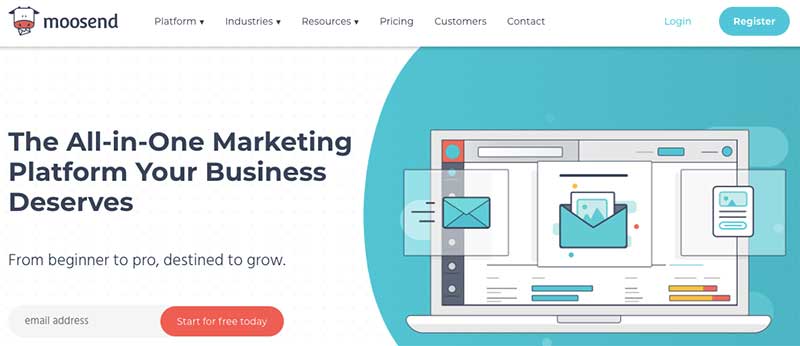
![Conversion.ai Software Review [This Is RIDICULOUS!]](https://topguide4you.com/wp-content/uploads/2021/05/Conversion.ai-Software-Review-1-100x70.png)

